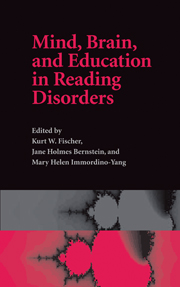Book contents
- Frontmatter
- Contents
- List of figures
- List of tables
- List of contributors
- Acknowledgements
- Part I What is Reading, and What are Reading Disorders? Looking to Neuroscience, Evolution, and Genetics
- Part II Reading and the Growing Brain: Methodology and History
- Part III Watching Children Read
- 10 Finding common ground to promote dialogue and collaboration: using case material to jointly observe children's behavior
- 11 Analyzing the reading abilities of four boys: educational implications
- 12 First impressions: What four readers can teach us
- 13 Analysis of reading disorders from a neuropsychological perspective
- 14 An educational/psychological perspective on the behaviors of three children with reading disabilities
- Part IV Reading Skills in the Long Term
- Appendix: Transcript and behavioral data from Profiles in Reading Skills (Four Boys)
- Index
- References
14 - An educational/psychological perspective on the behaviors of three children with reading disabilities
Published online by Cambridge University Press: 22 September 2009
- Frontmatter
- Contents
- List of figures
- List of tables
- List of contributors
- Acknowledgements
- Part I What is Reading, and What are Reading Disorders? Looking to Neuroscience, Evolution, and Genetics
- Part II Reading and the Growing Brain: Methodology and History
- Part III Watching Children Read
- 10 Finding common ground to promote dialogue and collaboration: using case material to jointly observe children's behavior
- 11 Analyzing the reading abilities of four boys: educational implications
- 12 First impressions: What four readers can teach us
- 13 Analysis of reading disorders from a neuropsychological perspective
- 14 An educational/psychological perspective on the behaviors of three children with reading disabilities
- Part IV Reading Skills in the Long Term
- Appendix: Transcript and behavioral data from Profiles in Reading Skills (Four Boys)
- Index
- References
Summary
Overview: From an educational perspective, deriving meaning from text is paramount, and all other reading processes subserve this goal. Torgesen suggests that dyslexia be described at two levels that reflect this fact – the primary level of cognitive and neurophysiological deficits and the secondary level of behavioral and comprehension deficits that are associated with, but not necessarily caused by, neurological conditions. He shows how these two levels work with the four boys whom he was asked to analyze. In the end, while primary deficits will manifest in timed measures, phonological problems, and other reading-related subskills, secondary deficits seem to matter more in educational contexts. Children often build skills that work around their primary deficits so that they have virtually no secondary deficits. Analyzing brain–behavior correlations and their relations to educational functioning requires distinguishing these two levels of reading disorder.
The EditorsIn this essay, I will discuss the behaviors of four children performing several reading and non-reading tasks from an educational/psychological perspective. I would like to begin with the simple observation that it is easy for researchers like myself to lose sight of the full individuality of children with reading disabilities when we spend most of our time thinking about the children only in terms of patterns of scores on a narrowly selected set of tests. Although William, Brian, and Andrew were all similar because they had experienced difficulties in learning to read to varying degrees, they each have complex personalities and response styles that are uniquely their own.
- Type
- Chapter
- Information
- Mind, Brain, and Education in Reading Disorders , pp. 243 - 252Publisher: Cambridge University PressPrint publication year: 2007
References
- 3
- Cited by



